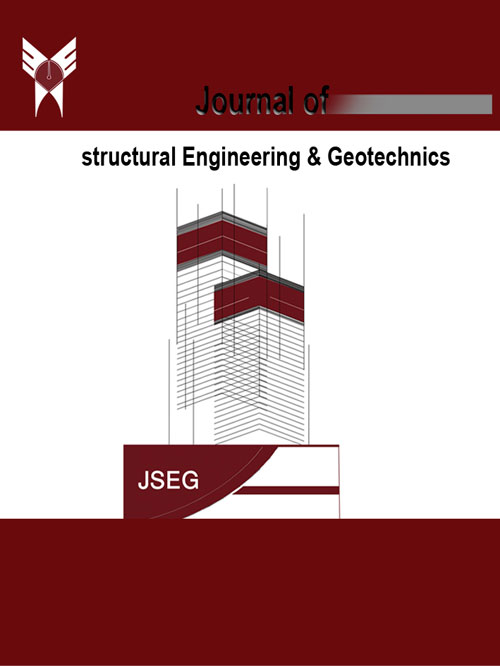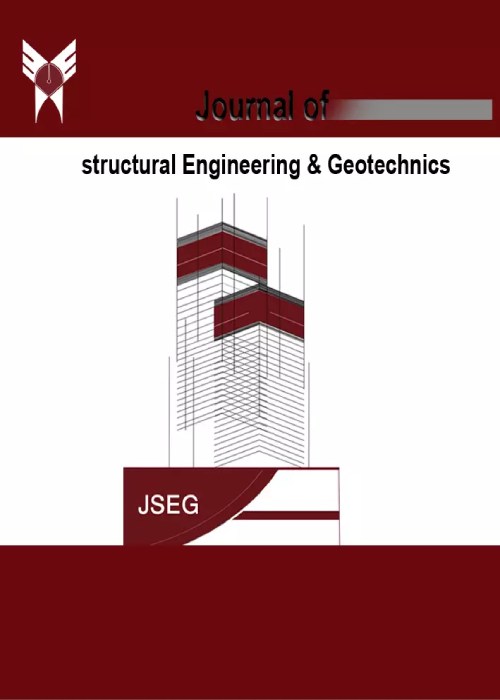فهرست مطالب

Journal of the Structural Engineering and Geotechnics
Volume:5 Issue: 2, Spring 2015
- تاریخ انتشار: 1394/05/30
- تعداد عناوین: 6
-
Pages 1-23Additional dampers are employed in order to decrease the dynamic response of structure against the earthquake and wind loading recently. In this study, two types of systems related to waste of inactive energy, i.e. frictional damper which is categorized in dampers dependent on movement and viscoelastic damper which is categorized in dampers dependent on velocity, in making steel structures resistant are investigated and evaluated. Results of structures with dampers (viscoelastic damper, friction damper and combination of both dampers) were compared with the results of structures without damper. Increasing trend in dissipating energy was observed. Then, the behavior of these dampers in frames of 4, 8 and 12 stories was studied by modeling the damper directly. The analyses were conducted via nonlinear time history technique and by using earthquake records (near fault and far fault) scaled with peak acceleration and SAP 2000 14.2.2 software. The results indicate the appropriate function of the selected dampers in controlling and decreasing the seismic responses of the structure. Given that in frictional dampers the maximum force created in the damper is specified, the use of this damper in resistance building of structures is very effective especially by considering the limitation of structure capacity.Keywords: Passive damping, Seismic excitation, Viscoelastic damper, Friction damper, Non, linear Dynamic Analysis
-
Pages 25-34In this paper a new isolating system is introduced for short to mid-rise buildings. In comparison to conventional systems such as LRB and HRB, the proposed system has the advantage of no need to cutting edge technology and has low manufacturing cost. This system is made up of two orthogonal pairs of pillow-shaped rollers that are located between flat bed and plates. By using this system in two perpendicular directions, building can move in all horizontal directions with respect to its foundation. Due to the pillow shape of the roller, this system has self-centering capability which causes it to return to its original position after the earthquake. The rolling friction force between pillows and their bed creates some damping in the system which prevents it from further oscillation after earthquake excitations diminish. The purpose of this study is to evaluate the proposed isolation system’s performance under different earthquake excitations. First of all general features of the proposed isolators have been introduced followed by the analytical equations of the system. Vertical bearing capacity and the effects of the thickness of pillows has been investigated using ABAQUS software. It has been shown that for a pair of pillows of 58 cm width, 45 cm height and 100 cm length the vertical load bearing capacity of the system is more than 300 tons. The period of system with respect to the height and radius of curvature of the rollers, and seismic response of a building, assumed as a rigid body resting on isolators, has been studied subjected to simultaneous effects of horizontal and vertical excitations. It has been shown that the proposed system can reduce the absolute acceleration in the building around 78% in average, while the building’s maximum displacement is around 1.77 times of the ground in average.Keywords: Rolling Isolation, Lagrange Equation, Runge, Kutta Technique, Finite element analysis
-
Pages 35-44Seismic base isolation are devices that used to limit the human and material damage caused by an earthquake. This devices diffuse the energy induced at the time of the earthquake before being transferred to the structure.The base isolated structures when subjected to the near-fault eathquakes which contain long-period velocity pulses that may coincide with the period of base isolated structures resulting in excessive deformation and rupture of isolators. Parameters of base isolation such as the yield strength and post yield stiffness ratio have significent effect on the displacement of isolation system. To study this effect, influence of these parameters on the dynamic response of the isolated structures in term of displacment, acceleration, base shear and absorbed energy has been studied. The results show that the increase in the bearing yield strength can reduce the bearing displacment signficantly without much alterning to the superstructure accelerations. Also the optimum yield strength and post yield stiffness ratio of the LRB is found to be in range of 0.8% - 1% of the total weight of the building and 0.08 – 0.12 of the ratio of plastic stiffness to elastic stiffness of base isolation respectively under near fault motions.Keywords: Lead rubber bearing, Yield strength, bearing displacement, Dynamic response
-
Pages 45-49Nowadays, tunneling in urban areas is a common activity for a variety of transportations such as subways, water supply, lifelines andsewers that may require blast operations. The characteristics of stress waves of the blast are quite different from earthquake waves. The blast waves are usually of high frequency content, short duration, equality of amplitudes in horizontal and vertical directions and large range of magnitude from ten to thousands of the gravitational constant. However few papers can be found to discuss about the effect of soil characteristics under blast loading. In this paper, numerical models based on finite element method is used to simulate stress wave at soil sites under explosion effect in an underground linear chamber and then characteristics of the ground movement and the explosion effect on soil-structure interaction is analyzed. In this study, numerical results of area deformations in every region are compared together and parameter sensitivity of the soil is analyzed. Results presented in this paper can be used in a more detailed assessment of ground motion effect on structures.Keywords: Subsurface explosions, dynamic settlement, ground vibration, Peak particle velocity
-
Pages 51-58As regards if curing stops for some time and then resumes again, then strength gain will also stop and reactive, in this study with choose suitable curing conditions after improper first curing (recurring) for normal and silica-fume concrete, Effect of this curing conditions on strength and permeability was investigated. The results from tests such as compressive strength, capillary water absorption and water penetration under pressure, indicates that curing after 28 days for concretes with improper first curing, especially for silica-fume concretes could be effective and reduction permeability and increase compressive strength of concretes was observedKeywords: Recurring, Silica, fume, Compressive strength, Water penetration under pressure, Capillary Absorption
-
Pages 59-67In this study the performance of clay nano-particles on the soil reinforced with Polypropylene fibers (PP-fiber) has been investigated. Also a series of investigations concerning the effect of random orientation of fibers on the engineering behaviour of soil were conducted. Soil mixtures were modified with varying percentages of nanoclay and Fibers. Unconfined compressive strength (UCS), Compaction, Atterberg limits, and microstructural (scanning electron microscopy) tests were conducted. In order to understand the micromechanical behaviour of nanoclay in fiber reinforced soil, the microstructure and morphology of fracture surfaces of samples were studied using Scanning Electron Microscopy (SEM). It was found that the addition of nanoclay significantly improves the performance of fiber reinforced soil in a unique way. This paper presents the understanding of nanoclaybehaviour and its impact on the overall mechanical characteristic and laboratory performance of fiber reinforced soil.Keywords: Nanoclay, ýþiF þýbersýþ, þý Soil Reinforcement


